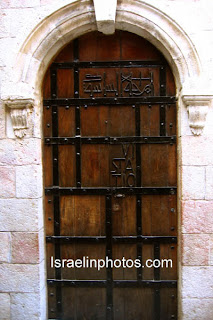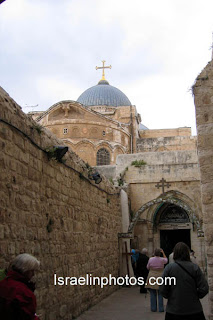Traditionally the path that Jesus walked on the way to his crucifixion. There are fourteen Stations on the Via Dolorosa, nine alomg the route (the first seven stations wind through the Muslim Quarter) and the last five stations are inside the Church of the Holy Sepulchre.
Station I - Jesus is condemned to death.
Station II - Jesus receives the cross.
Station III - Jesus falls under the cross for the first time.
Station IV - Jesus meets his mother.
Station V - Simon of Cyrene, the man conscripted to help Jesus carry his cross.
Station VI - Veronica wipes Jesus' face.
Station VII - Jesus falls for the second time.
Station VIII - Jesus meets the women of Jerusalem.
Station IX - Jesus falls for the third time.
Station X - Jesus is stripped of his garments.
Station XI - Jesus is nailed to the cross.
Station XII - Jesus dies on the cross.
Station XIII - Jesus' body was taken down from the cross. Station XIV - The tomb of Jesus.
The tradition to walk the present route was set in the Crusader period in the 13th century, and was finally established in the 19th century.
The traditional route starts just inside the Lions' Gate (St. Stephen's Gate), at the Umariya Elementary School, near the location of the former Antonia Fortress, and winds its way westwards towards the Church of the Holy Sepulcher. There are 14 Stations on the Via Dolorosa, 9 along the route and 5 inside the Church of the Holy Sepulcher.
Ecce Homo - Ecce Homo are the Latin words used by Pontius Pilate in the Vulgate translation of the Gospel of John (19:5). Hadrian (76-138 CE) erected a triple arch as a gate, originally part of a triumphal gate in Hadrian’s Aelia Capitoline. The largest of these arches is known as the 'Ecce Homo Arch'. It spans the Via Dolorosa and continues into the Church of Ecce Homo where the smaller northern section can be seen.
Convent of the Sisters of Zion - The Struthion Pool, a subterranean cistern for collection of rainwater,is hewn out of the rock and has a row of arches and a vaulted roof. The Pool was mentioned by Josephus Flavius (Jewish Wars 5, 11, 4).
3rd Station on the Cross - commemorates the spot where Jesus fell under the weight of the cross. The place is marked by a small chapel belonging to the Armenian Catholic Patriarchate, who purchased the site in 1856 It is a nineteenth century building renovated and completed by Catholic soldiers of the Free Polish Army during World War II.
4th Station on the Cross - The Armenian Chapel symbolizes the place where Jesus passed his mother Mary while carrying his cross.
5th Station of the Cross - a Franciscan chapel built in 1895 and called after Simon of Cyrene, who was compelled by the Roman soldiers to help Jesus carry the cross (Matthew 27:32, luke 23:26).
6th Station of the Cross - According to tradition Veronica was the woman who wiped the blood and dirt from Jesus' face, and his image remained on the cloth which she used. Therefore her name Vera Icone, 'true image'.
7th Station of the Cross - According to tradition, this was the site of the Gate of Judgment where the names of the accused and their sentence were posted before they went out of the city wall.
8th Station of the Cross - According to tradition, the spot where Jesus said to the lamenting women of jerusalem: 'Daughters of Jerusalem, do not weep for me but weep rather for yourselves and for your children'(Luke 23:27).
9th Station of the Cross - entrance of a Coptic monastery church and the pillar that marks the 9th Station.






















